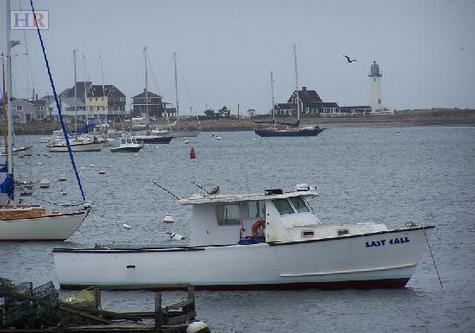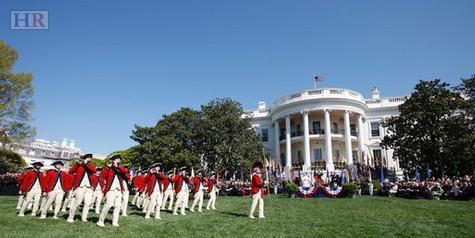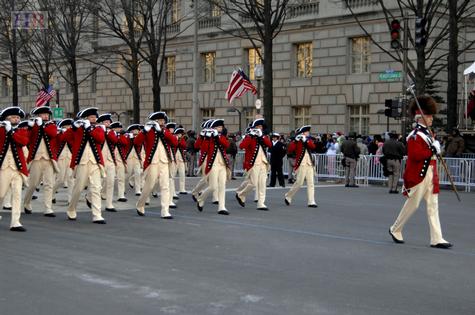Rock Stars of Holliston, and Where They Play Now
Local folklore has it that George Washington and his men stopped at Balancing Rock on Route 16 and challenged each other to tip a very heavy top rock off of its base. No doubt there was a fifer and drummer or two among the ranks of Washington’s men. What significance did these minstrels have in the Continental Army and where do they play these days? The answer may surprise you.
It’s true, the fife and drum corps of the Revolutionary and Civil Wars were used to break up the monotony of long marches, but their much more important function was to communicate signals on the battlefield above the roar of cannon fire. During our fight for independence, the distance of communications was sometimes up to five miles. The fife and drummers were also used to inform troops when to charge, when to cease-fire, when to assemble; also when to eat, work, sleep, and when to be on alert. Before church bells were made, drummers notified citizens of public events and happenings. Before that, it was the town crier who spread the news.

The Mustering Tradition.
The Deep River Ancient Muster in Connecticut is the largest gathering of fife and drum corps in the United States. Each year in July, these “Yankee Doodles” of up to 80 bands converge on Deep River, formerly known as Saybrook and parade along Main Street dressed in colonial and Civil War attire. The music is played in the same style as it has been for the past 145 years. The Deep River contingent traces its roots back to May 13th, 1879.
Scituate's Bates Sister Outfox the British.

During the War of 1812, The Royal British Navy sailed up and down the New England Coast eager to sack any town they could. The Scituate lighthouse keeper, Simeon Bates was away when the British decided on another attack on the town. Simeon’s two daughters, Rebecca and Abigail saw the British sailors and marines landing and fended off an attack by playing the fife and drum out of sight of the soldiers. The Red Coats thought they were hearing Continental troops close by and decided against an attack. The Bates sisters became known as “The American Army of Two.” Hats off and high fives to the Bates sisters, Sybil Ludington, Molly Pitcher and the hundreds of other heroines of the Revolutionary War.
.jpg)
The most distinguished fife and drum corps these days is one of four premier musical groups of the United States Army, 3rd U.S. Infantry, stationed at Fort Myer, Virginia. It was founded on 23, February, 1960. During arrival ceremonies for visiting heads of state, The Old Guard Fife and Drum Corps perform their “troop step,” a slow colonial ceremonial step on the south lawn of The White House. They dress in colonial uniforms and play “Yankee Doodle” to the delight of the audience. Instead of a mace, the drum major carries an espontoon, an 18th century weapon carried by officers. He uses it to issue silent commands to the Corps.
All musicians in the Corps are full-time Active Duty Soldiers in the United States Army. All members also complete Basic Combat Training and after they pass an audition, they are permanently assigned to the Old Fife and Guard Corps for their entire enlistment.
Let's Play at the White House

Each year, the Corps performs up to 500 musical gigs a year, using from 12 to 22 to 33 soldiers at each event. They perform in parades, at The White House, at civic and sporting events and special shows, but I’m sure you will agree, they are all special. For more information about the Old Guard Fife and Drum, Google them at: The United States Army Old Guard Fife and Drum Corps.

******************************************************************************************************************
 Charles Collie is a former reporter for a CBS television station in Ohio. Charlie and his family moved to Holliston in 1995. He is semi-retired and still enjoys writing about politics and current events.
Charles Collie is a former reporter for a CBS television station in Ohio. Charlie and his family moved to Holliston in 1995. He is semi-retired and still enjoys writing about politics and current events.
Interesting article between you and Frank. Didn't know how important the Fife and Drum Corps were and how vital it was to see them with their bright color uniforms. Thank you Charlie, Mary
Mary Patch | 2016-03-01 17:24:05
Thanks Charlie. You probably noticed I didn't question whether Washington and his somewhat truncated retinue actually stopped at Balancing Rock or not - just whether he had his army in tow. Folklore is a fascinating subject, and particularly when historical icons (like GW) are involved tends to draw strong opinions from both backers and debunkers. I'm not going to question whether Washington tried to tip over the Balancing Rock just because he didn't happen to mention it in his diary - I'd like to think that just maybe the Father of His Country decided to see if he actually could shift a portion of it for himself. Who knows -- maybe if we looked closely enough, we could even find where he carved his initials (put down the hammer and cold chisel, Paul).
Frank Chamberlain | 2016-03-01 08:57:16
Thanks for the comment Frank. The definition of folklore which I used in the first sentence is: Folklore: ideas or stories that are not true but that many people have heard or read. As a former reporter for CBS television, and eyewitness to history, I can say with absolute certainty that I saw Washington and his men at Balancing Rock in 1789. I guess that dates me! Glad you enjoy reading my stories.
Charles Collie | 2016-02-29 20:57:56
Good article - however, when George Washington visited Holliston in November, 1789, it was while on a tour of the northern states shortly into his first term as President and not as Commander in Chief of the Continental Army. On the first day of his journey - maybe the first presidential junket - Washington mentions "Major Jackson, Mr. Lear and myself, with six servants, which composed my Retinue". So, sadly, those marching musicians in their bright coats would not have accompanied him on his passage through Holliston. Too bad. However, the major point in the article about the 3rd US Infantry is spot-on. One historical tidbit not mentioned in the article involves the color of the uniforms. Why would American soldiers wear red coats - didn't British soldiers always wear red? Musicians of the period wore uniforms in the reverse colors of their regiments so they could be easily located in the smoke and confusion of battle. As the author correctly points out, these soldiers were the communications specialists of their time and if General Washington wanted to communicate a command via drum signal, he didn't want spent five minutes searching for drummer - he wanted them to visually stand out. So the 3rd Infantry wears the uniform of a regiment which wore blue coats with red trim - the first US Army uniform. British musicians during the Revolutionary War might have worn coats of yellow, blue, green, buff, white - even purple - all with red trim. So all-in-all, a far more colorful period, military uniform-wise. If you want to see and hear a New England based unit that rivals the Old Guard in sartorial splendor and musical ability, check out the Middlesex County Volunteers (www.mcvfifesanddrums.org). Their uniforms are white with blue trim - mirroring the blue coats "turn'd up with white" popular with New England regiments in the later years of the Revolution. Please keep the articles coming, Charlie - even though I can't resist the opportunity to stick in my 2 cents worth (always a major failing amongst history buffs, I know) I always look forward to reading them.
Frank Chamberlain | 2016-02-29 15:23:24